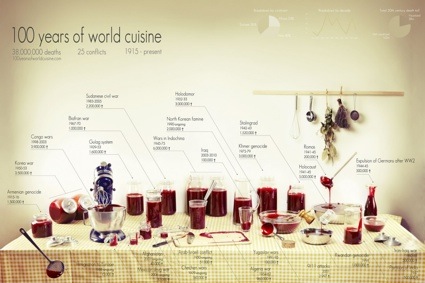“Ten casualties. Ten million casualties. Our understanding of conflicts is often nothing more than a handful of digits, the more precise, the less meaningful. The anchor’s tone remains the same when talking about major wars or isolated outbursts of violence. The horror lays hidden beneath the rigidity of numbers. Figures give us knowledge, not meaning. “
For individuals under attack, hierarchies of suffering are callous in the extreme – a death is a death, a mutilation is a mutilation. But what shapes the decisions and priorities of far-away activists and advocates?
100 Years of World Cuisine is data art visualising 38 million deaths in 25 conflicts from 1915 to the present.
That’s a little less than a quarter of the total.
(Once on the page click on the image until it doesn’t get any bigger.)


April 13, 2012 at 12:28 pm
kind of odd to list the dates of the arab-israeli conflict from 1950-present.
April 13, 2012 at 12:51 pm
Also wondering about the 5m Holocaust toll with the Roma but not the gay, disabled and dissident victims identified separately. And what are the crosses denoting? And wondering where the Sri Lanka Sinhalese v. Tamil with Muslims in the crossfire conflict fits in. As the authors disclaim, this is ultimately a piece of art and not created to withstand scrutiny on grounds of ‘scientificity’ – I think it works well in terms of its aims of impact and perspective.
April 13, 2012 at 3:30 pm
Interesting to note the 4th smallest number of deaths (that is, 4th up from the “bottom”). Wonder what the anti-zionists will make of “only” 51,000 deaths from the I/P conflict (admittedly, it’s still 51,000 too many), when compared with all the other figures.
A contemporary version of the “20th Century Book of the Dead”, published, I recall, some 20 years ago.
April 13, 2012 at 10:58 pm
it’s a lot more if you go back to ’48 — from wiki: Israel lost 6,373 of its people, about 1% of its population, in the war. About 4,000 were soldiers and the rest were civilians.[149] The exact number of Arab losses is unknown, but is estimated at between 8,000[9] and 15,000.[10]